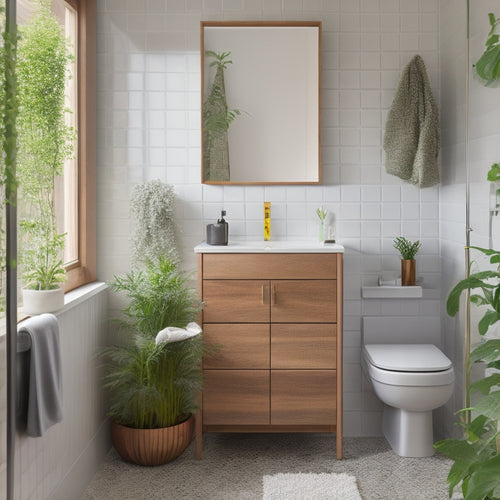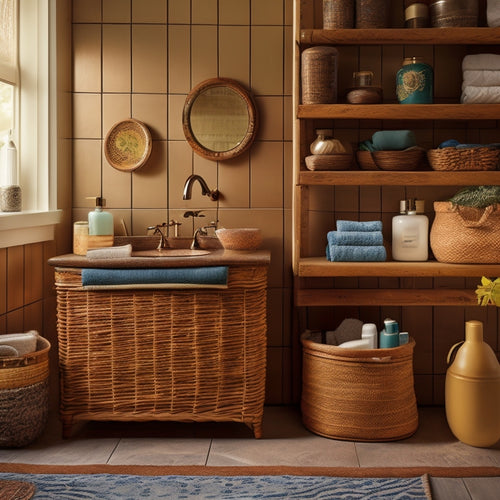
Sparkling Secrets: Master Bathroom Cleaning Guide
Share
A thorough bathroom cleaning strategy involves more than just a few essential tools, it requires a detailed understanding of the tasks and techniques necessary to achieve a truly sparkling space. Start by gathering the necessary supplies, including a toilet brush, disinfectant spray, microfiber cloths, scrubber, and mop. Then, tackle the toilet and shower, focusing on deep cleaning high-traffic areas, preventing mold and mildew, and scrubbing away at stubborn grout. Finally, move on to sparkling surfaces and floors, paying attention to daily, weekly, and bi-weekly cleaning schedules. From here, discover the secrets to a bathroom that shines from top to bottom.
Key Takeaways
• Use a toilet brush, disinfectant spray, and microfiber cloths to keep the toilet area clean and hygienic.
• Deep clean the toilet and shower by scrubbing grout, preventing mold, and cleaning the toilet bowl and showerhead.
• Clean countertops daily with a microfiber cloth and gentle cleaner to maintain sparkling surfaces.
• Mop the floors weekly with a gentle cleaner and warm water to keep them clean and shiny.
• Clean mirrors bi-weekly with glass cleaner and a lint-free cloth to remove streaks and smudges.
Bathroom Cleaning Essentials
Seven must-have items form the foundation of a thorough bathroom cleaning arsenal: a toilet brush, disinfectant spray, microfiber cloths, a scrubber, a mop, paper towels or a sponge, and a toilet cleaner.
These essential cleaning tools enable effective disinfectant techniques, ensuring a hygienic and sparkling bathroom. The toilet brush and scrubber tackle tough stains and grout, while microfiber cloths and paper towels or a sponge are perfect for wiping down surfaces.
Disinfectant spray and toilet cleaner provide a powerful one-two punch against germs and bacteria. With these must-haves, you'll be well-equipped to tackle even the toughest bathroom messes.
Toilet and Shower Deep Clean
With the fundamental cleaning tools in place, attention can now shift to the often-neglected areas of the bathroom that require a deeper level of cleaning, specifically the toilet and shower. These areas tend to harbor dirt, grime, and mold, making them essential to tackle in a deep clean.
To effectively deep clean the toilet and shower, consider the following steps:
-
Grout scrubbing: Use a grout brush and cleaner to remove dirt and grime from between tiles.
-
Mold prevention: Regularly clean and dry shower walls and floors to prevent mold growth.
-
Toilet bowl scrubbing: Use a toilet brush and cleaner to remove stubborn stains and mineral deposits.
-
Showerhead cleaning: Soak showerheads in vinegar to remove mineral buildup and improve water pressure.
-
Tile and grout sealing: Apply a sealant to protect tiles and grout from stains and water damage.
Sparkling Surfaces and Floors
Sparkling surfaces and floors are the hallmark of a meticulously cleaned bathroom, and achieving this requires attention to detail and a thorough understanding of the most effective cleaning techniques. A well-cleaned bathroom exudes a sense of luxury and sophistication, making it essential to focus on floor shining and countertop gleaming.
| Surface | Cleaning Technique | Frequency |
|---|---|---|
| Countertops | Microfiber cloth and gentle cleaner | Daily |
| Floors | Mop with gentle cleaner and warm water | Weekly |
| Mirrors | Glass cleaner and lint-free cloth | Bi-Weekly |
| Sinks | Soap and warm water, then dry with microfiber cloth | Daily |
Frequently Asked Questions
How Often Should I Clean My Bathroom to Maintain Cleanliness?
To maintain cleanliness, establish a daily routine of quick pick-ups and a weekly cleaning schedule, allocating tasks such as toilet cleaning, mirror wiping, and floor mopping to guarantee a consistently hygienic and organized bathroom environment.
What Is the Best Way to Remove Stubborn Soap Scum Buildup?
To effectively remove stubborn soap scum buildup, utilize scum solvents specifically designed for bathroom surfaces. Apply the solvent according to the manufacturer's instructions, then wipe clean with a microfiber cloth or scrubber, and finally, install shower shields to prevent future buildup.
Can I Use Bleach to Clean My Bathroom Surfaces and Fixtures?
As a beacon of caution, it is crucial to exercise Bleach Safety when considering its use on bathroom surfaces and fixtures. Instead, opt for Bleach Alternatives like vinegar or baking soda, which are gentler and more environmentally friendly.
How Do I Prevent Mildew and Mold Growth in My Bathroom?
To prevent mildew and mold growth, guarantee good ventilation by installing effective ventilation systems, such as exhaust fans, and utilizing humidity controllers to maintain ideal humidity levels, especially in areas prone to moisture accumulation.
Are There Eco-Friendly Alternatives to Harsh Chemical Cleaners?
As you step into your bathroom, envision a haven where nature's essence reigns supreme. Explore green alternatives to harsh chemical cleaners, opting for natural substitutes like baking soda, vinegar, and essential oils, which effectively combat grime while nurturing the environment.
Related Posts
-

Small Bathroom Cabinet Design Inspiration
If you're looking for small bathroom cabinet design inspiration, think vertical! Employ wall-mounted racks and floati...
-

Vintage Bathroom Storage Ideas for Large Families
You can easily boost your large family's bathroom with vintage storage ideas that marry style and function. Think rep...
-

Get Your Quirky Designs Now
Express your individuality with vibrant, one-of-a-kind designs that celebrate self-expression and quirky humor. Disco...


